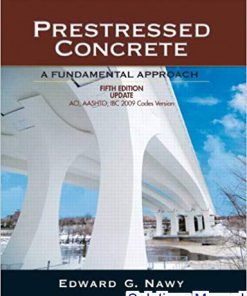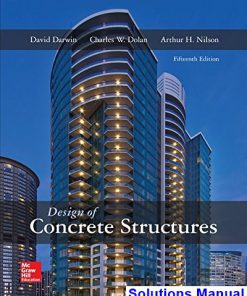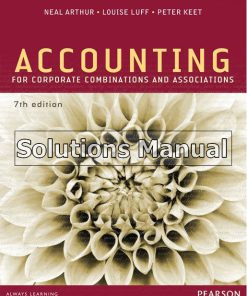Reinforced Concrete Design 8th Edition Limbrunner Solutions Manual
$26.50$50.00 (-47%)
Reinforced Concrete Design 8th Edition Limbrunner Solutions Manual.
You may also like
Instant download Reinforced Concrete Design 8th Edition Limbrunner Solutions Manual pdf docx epub after payment.

Product details:
- ISBN-10 : 0132859297
- ISBN-13 : 978-0132859295
- Author:
Reinforced Concrete Design Eighth Edition integrates current research and literature to give readers a modern understanding of the strength and behavior of reinforced concrete members and simple reinforced concrete structural systems. It takes a fundamental, non-calculus, practice-oriented approach to the design and analysis of reinforced concrete structural members, using numerous examples and a step-by-step solution format.
Table of contents:
- INTRODUCTION
- 1-1 Reinforced Concrete Structures
- 1-2 Mechanics of Reinforced Concrete
- 1-3 Reinforced Concrete Members
- 1-4 Factors Affecting Choice of Reinforced Concrete for a Structure
- 1-5 Historical Development of Concrete and Reinforced Concrete as Structural Materials
- 1-6 Building Codes and the ACI Code
- References
- THE DESIGN PROCESS
- 2-1 Objectives of Design
- 2-2 The Design Process
- 2-3 Limit States and the Design of Reinforced Concrete
- 2-4 Structural Safety
- 2-5 Probabilistic Calculation of Safety Factors
- 2-6 Design Procedures Specified in the ACI Building Code
- 2-7 Load Factors and Load Combinations in the 2019 ACI Code
- 2-8 Loadings and Actions
- 2-9 Design for Economy
- 2-10 Sustainability
- 2-11 Customary Dimensions and Construction Tolerances
- 2-12 Inspection
- 2-13 Accuracy of Calculations
- 2-14 Handbooks and Design Aids
- References
- MATERIALS
- 3-1 Concrete
- 3-2 Behavior of Concrete Failing in Compression
- 3-3 Compressive Strength of Concrete
- 3-4 Strength Under Tensile and Multiaxial Loads
- 3-5 Stress-Strain Curves for Concrete
- 3-6 Time-Dependent Volume Changes
- 3-7 High-Strength Concrete
- 3-8 Lightweight Concrete
- 3-9 Fiber Reinforced Concrete
- 3-10 Durability of Concrete
- 3-11 Behavior of Concrete Exposed to High and Low Temperatures
- 3-12 Shotcrete
- 3-13 Reinforcement
- 3-15 Fiber-Reinforced Polymer (FRP) Reinforcement
- 3-16 Prestressing Steel
- References
- FLEXURE: BEHAVIOR AND NOMINAL STRENGTH OF BEAM SECTIONS
- 4-1 Introduction
- 4-2 Flexure Theory
- 4-3 Simplifications in Flexure Theory for Design
- 4-4 Analysis of Nominal Moment Strength for Singly Reinforced Beam Sections
- 4-5 Definition of Balanced Conditions
- 4-6 Code Definitions of Tension-Controlled and Compression-Controlled Sections
- 4-7 Beams With Compression Reinforcement
- 4-8 Analysis of Flanged Sections
- References
- FLEXURAL DESIGN OF BEAM SECTIONS
- 5-1 Introduction
- 5-2 Analysis of Continuous One-Way Floor Systems
- 5-3 Design of Singly Reinforced Beam Sections with Rectangular Compression Zones
- 5-4 Design of Doubly Reinforced Beam Sections
- 5-5 Design of Continuous One-Way Slabs
- References
- SHEAR IN BEAMS
- 6-1 Introduction
- 6-2 Basic Theory
- 6-3 Behavior of Beams Failing in Shear
- 6-4 Analysis and Design of Reinforced Concrete Beams for Shear—ACI Code
- 6-5 Other Shear Design Methods
- 6-6 Hanger Reinforcement
- 6-7 Shear in Axially Loaded Members
- References
- TORSION
- 7-1 Introduction and Basic Theory
- 7-2 Behavior of Reinforced Concrete Members Subjected to Torsion
- 7-3 Thin-Walled Tube Analogies
- 7-4 Design for Torsion and Shear—ACI Code Approach
- 7-5 ACI Code Design Method for Torsion
- References
- DEVELOPMENT, ANCHORAGE, AND SPLICING OF REINFORCEMENT
- 8-1 Introduction
- 8-2 Mechanism of Bond Transfer
- 8-3 Development Length
- 8-4 Hooked Anchorages
- 8-5 Headed Bars in Tension
- 8-6 Design for Anchorage
- 8-7 Bar Cutoffs and Development of Bars in Flexural Members
- 8-8 Reinforcement Continuity and Structural Integrity Requirements
- 8-9 Splices
- References
- SERVICEABILITY
- 9-1 Introduction
- 9-2 Elastic Analysis of Stresses in Beam Sections
- 9-3 Cracking
- 9-4 Deflections of Concrete Beams
- 9-5 Consideration of Deflections in Design
- 9-6 Frame Deflections
- 9-7 Vibrations
- 9-8 Fatigue
- References
- CONTINUOUS BEAMS AND ONE-WAY SLABS
- 10-1 Introduction
- 10-2 Continuity in Reinforced Concrete Structures
- 10-3 Continuous Beams
- 10-4 Design of Girders
- 10-5 Joist Floors
- References
- COLUMNS: COMBINED AXIAL LOAD AND BENDING
- 11-1 Introduction
- 11-2 Tied and Spiral Columns
- 11-3 Interaction Diagrams
- 11-4 Interaction Diagrams for Reinforced Concrete Columns
- 11-5 Design of Short Columns
- 11-6 Contributions of Steel and Concrete to Column Strength
- 11-7 Biaxially Loaded Columns
- References
- SLENDER COLUMNS
- 12-1 Introduction
- 12-2 Behavior and Analysis of Pin-Ended Columns
- 12-3 Design of Columns in Nonsway Frames
- 12-4 Behavior of Restrained Columns in Sway Frames
- 12-5 Calculation of Moments in Sway Frames Using Second-Order Analysis
- 12-6 Design of Columns in Sway Frames
- 12-7 General Analysis of Slenderness Effects
- 12-8 Torsional Critical Load
- References
- TWO-WAY SLABS: BEHAVIOR, ANALYSIS, AND DESIGN
- 13-1 Introduction
- 13-2 History of Two-Way Slabs
- 13-3 Behavior of Slabs Loaded to Failure in Flexure
- 13-4 Analysis of Moments in Two-Way Slabs
- 13-5 Distribution of Moments in Slabs
- 13-6 Design of Slabs
- 13-7 The Direct-Design Method
- 13-8 Equivalent-Frame Analysis Methods
- 13-9 Shear Strength of Two-Way Slabs
- 13-10 Combined Shear and Moment Transfer in Two-Way Slabs
- 13-11 Details and Reinforcement Requirements
- 13-12 Design of Slabs Without Beams
- 13-13 Construction Loads on Slabs
- 13-14 Deflections in Two-Way Slab Systems
- 13-15 Use of Post-Tensioning
- References
- TWO-WAY SLABS: ELASTIC AND YIELD-LINE ANALYSES
- 14-1 Review of Elastic Analysis of Slabs
- 14-2 Design Moments from a Finite-Element Analysis
- 14-3 Yield-Line Analysis of Slabs: Introduction
- 14-4 Yield-Line Analysis: Applications for Two-Way Slab Panels
- 14-5 Yield-Line Patterns at Discontinuous Corners
- 14-6 Yield-Line Patterns at Columns or at Concentrated Loads
- References
- FOOTINGS
- 15-1 Introduction
- 15-2 Soil Pressure Under Footings
- 15-3 Structural Action of Strip and Spread Footings
- 15-4 Strip or Wall Footings
- 15-5 Spread Footings
- 15-6 Combined Footings
- 15-7 Mat Foundations
- 15-8 Pile Caps
- References
- SHEAR FRICTION, HORIZONTAL SHEAR TRANSFER, AND COMPOSITE CONCRETE BEAMS
- 16-1 Introduction
- 16-2 Shear Friction
- 16-3 Composite Concrete Beams
- References
- DISCONTINUITY REGIONS AND STRUT-AND-TIE MODELS
- 17-1 Introduction
- 17-2 Struts
- 17-3 Ties
- 17-4 Nodes and Nodal Zones
- 17-5 Other Strut-and-Tie Elements
- 17-6 Layout of Strut-and-Tie Models
- 17-7 Deep Beams
- 17-8 Brackets and Corbels
- 17-9 Dapped Ends
- 17-10 Beam-Column Joints
- 17-11 Bearing Strength
- 17-12 T-Beam Flanges
- References
- WALLS AND SHEAR WALLS
- 18-1 Introduction
- 18-2 Bearing Walls
- 18-3 Retaining Walls
- 18-4 Tilt-Up Walls
- 18-5 Shear Walls
- 18-6 Lateral Load-Resisting Systems for Buildings
- 18-7 Shear-Wall-Frame Interaction
- 18-8 Coupled Shear Walls
- 18-9 Design of Structural Walls-General
- 18-10 Flexural Strength of Shear Walls
- 18-11 Shear Strength of Shear Walls
- 18-12 Critical Loads for Axially Loaded Walls
- References
- DESIGN FOR EARTHQUAKE RESISTANCE
- 19-1 Introduction
- 19-2 Seismic Response Spectra
- 19-3 Seismic Design Requirements
- 19-4 Seismic Forces on Structures
- 19-5 Ductility of Reinforced Concrete Members
- 19-6 General ACI Code Provisions for Seismic Design
- 19-7 Beams in Special Moment Frames
- 19-8 Columns in Special Moment Frames
- 19-9 Joints of Special Moment Frames
- 19-10 Structural Diaphragms
- 19-11 Structural Walls
- 19-12 Frame Members Not Proportioned to Resist Forces Induced by Earthquake Motions
- 19-13 Special Precast Structures
- 19-14 Foundations
- References
People Also Search:
principles of reinforced concrete design pdf
simplified reinforced concrete design pdf
fundamentals of reinforced concrete design by besavilla pdf
reinforced concrete design a practical approach 3rd edition
reinforced concrete slab design example
advanced reinforced concrete design by krishna raju pdf
basic concepts of reinforced concrete design












